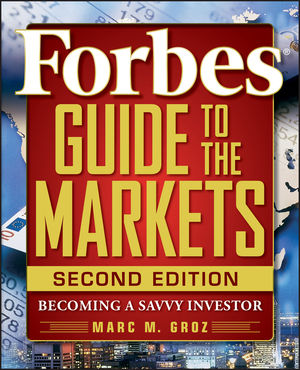Forbes Guide to the Markets: Becoming a Savvy Investor, 2nd EditionISBN: 978-0-470-46338-3
Paperback
320 pages
September 2009
 |
||||||
Acknowledgments xi
Note to the Reader xiii
About the Author xv
Introduction: Becoming a Savvy Investor xvii
Section I Establishing a Frame of Reference 1
Chapter One From “Dumb” Barter to Intelligent Agents 3
Chapter Two Point-Counterpoint 13
Stocks 14
Mutual Funds 14
Bonds 15
ETFs 15
Options 15
Futures 16
Summary 16
Chapter Three Confronting Information Overload 17
Investor Constraints 18
Investor Choices 19
Investor Safety 21
Section II Stocks and Equity Markets 23
Chapter Four Varieties of Stocks 27
Just What is a Security, Anyway? 27
Issuers and Underwriters: Why Does a Corporation Sell Stock to the Public? 29
Why Investors Buy Stock 34
Summing Up Total Return: Dividends and Capital Gains 35
A Letter to Our Shareholders: Annual and Quarterly Reports (and Filings) 41
Making Sense of Types, Classes, and Other Stock Categories: A Map of the World of Stock 41
Chapter Five Stock Markets 47
The Big Board 48
The Incredible Growth of Trading and Capital 58
National Association of Securities Dealers Automated Quotation System (NASDAQ) 61
Technology, Dark Pools, and the Evolution of a Unified Market 63
Chapter Six Three Views of the Numbers 65
Fundamental Analysis 66
Technical Analysis 70
Quantitative Analysis 80
Chapter Seven Where to Find Information on Stocks and Financial Markets 87
A Selection of Information Sources on the Financial Markets 91
Chapter Eight How to Buy and Sell Stock 99
Full-Service Brokers 100
Discount Brokers 102
Financial Intermediaries 103
Direct Purchase 104
If It Sounds Too Good to Be True . . . Protecting Yourself from Stock Scams 104
A Note on Financial Planners 106
Section III Mutual Funds and Investment Companies 109
Chapter Nine A History and Overview of the Mutual Fund Business 113
Open-End versus Closed-End Funds 117
Index Funds 118
Load versus No-Load Funds 119
Chapter Ten Advantages of Mutual Funds 121
Simplicity 121
Diversification 122
Access to New Issues 122
Economies of Scale 123
Professional Management 125
Indexing 125
Chapter Eleven Disadvantages of Mutual Funds 127
Impact of One-Time Charges and Recurring Fees on Fund Performance 127
Hidden Cost of Brokerage 130
Some Hidden Risks of Fund Ownership 132
Chapter Twelve Sources of Information on Mutual Funds 135
Investment Company Institute Classification of Types of Funds 136
Lipper Analytical Services 139
Forbes 140
Morningstar 140
Chapter Thirteen Alternative Investments 141
Hedge Funds 141
Funds of Hedge Funds 144
Other Alternatives 145
Section IV Bonds and Other Fixed-Income Securities 147
Chapter Fourteen Seven Characteristics of Bonds 151
The Lifespan of Bonds 152
Interest versus Discount 153
Relationship of Price to Yield 154
Four Important Yield Measures 154
Credit Quality, Ratings, and Insurance 155
Call and Related Features 155
Fixed versus Floating Rates and Foreign Currencies 156
Chapter Fifteen How the Other $30 Trillion is Invested 159
Treasuries 160
Corporates 170
Mortgage-Backed Securities and Other Asset-Backed Securities 171
Municipals 172
Money Market 174
Summary 175
Section V Options, Futures, and Other Derivatives 177
Chapter Sixteen Options 181
Exchange-Traded Options 183
Combination Strategies 185
Determining the Value of an Option 187
Chapter Seventeen Futures 193
A Seller’s Need to Hedge . . . 193
Some Buyers Need to Hedge, Too 194
Speculation or Insurance? Maybe a Little of Both 195
Actuals versus Cash-Settled Contracts 195
Margin and Collateral 196
Chapter Eighteen Other Derivatives 199
Section VI Summing Up Risk and Return 203
Chapter Nineteen How Well Are My Investments Doing? 207
The Basics of Return 208
Annualized Returns: Arithmetic (Simple) or Geometric (Compound)? 211
Time-Weighted Returns versus Money-Weighted Returns 216
Complicating Factors 220
Chapter Twenty Coming to Grips with the Many Dimensions of Risk 223
A Definition of Investment Risk 223
The Relativity of Risk 224
What is Market Risk? 226
“It Will Fluctuate” 227
Other Kinds of Investment Risk: From the Quantifiable to the Subjective 228
Balancing Risk and Return 232
Chapter Twenty-One A Crescendo of Change 235
Again, We Ask, What is a Market? 235
Glossary 239
Index 267



